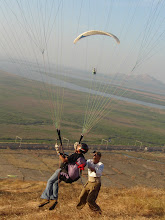Samson D’Silva is a trained paragliding instructor, actively promoting the sport in western Maharashtra. Tel: 95250-2586764. Mobile: 098224 99281. E-mail: samsondsilva@gmail.com
Paragliding has arrived in India and it is here to stay. This is the youngest, and comparatively, the cheapest form of air sports and is relatively new in India. There are many sites in the country where pilots of various skill levels can explore the fascinating world of paragliding.
Though one needs to fly for years to gain experience and do professional flying, the basics of paragliding could be picked up in a few hours. This is the only form of aviation activity where the pilot can actually take his first solo flight on day one!
There are two methods of learning paragliding – winch based and hill flying.
In hill flying one has to depend on the locations provided by nature with its limitations and obstructions like trees and rocks. Learning to fly by a winch is safer and easier than hill flying as one can take-off and land in open fields. The height can also be controlled because depending on the response of the student pilot, the winch operator can actually control the altitude between 200 to 600 feet above the ground, and the pilot then releases the tow rope and has a free flight downwards to the landing zone. This gives the beginner pilot lot of practice at take-off and landing without having to climb the hills, an exhausting activity by itself.
One eventually ends up flying from hills and mountains to be more independent, but by gaining experience on a winch, is better prepared to avoid the rocks, shrubs and trees. Also through winch flying it is easier to complete a basic course and be prepared to face adventures of hill flying. The first few flights are generally of a minute or two from the initial small training hill, and then between 20 and 30 minutes when the student pilot gains experience and understands the sport. These flights are extremely enjoyable, and although short, satisfy that dream of flying like a bird that many of us share. Even if this is all that paragliding had to offer, the sport would still be well worth it. However, paragliding offers much more: as the pilots gain more experience they enjoy the beauty, excitement and challenge of finding rising air to prolong their flights.
Paragliding pilots commonly use two forms of rising air. The basic form of rising air one encounters on hills, called ridge lift, is caused by a wind blowing over a ridge or hill. By flying within this rising air back and forth along the hill or ridge, the paraglider pilot can remain aloft for lengthy periods of time.
The second is thermals, which are large "bubbles" or "packets" of air that have been warmed on a sunny day, and that rise up thousands of feet into the air. By catching a thermal and circling within it, the paraglider pilot can actually gain height, and remain aloft for many hours.
One of the great challenges of paragliding is developing the skill and "feel for the air" to find and stay in such rising air. This challenge is one reason why pilots remain in paragliding for year after year. The next step for a paraglider pilot is cross-country flying, where the pilot keeps on moving from one rising packet of air to another and covering long distances. Cross-country flights are possible on a winching as one gets launched straight in to a thermal. But that is something that requires more than beginners skills!
Subscribe to:
Post Comments (Atom)

No comments:
Post a Comment